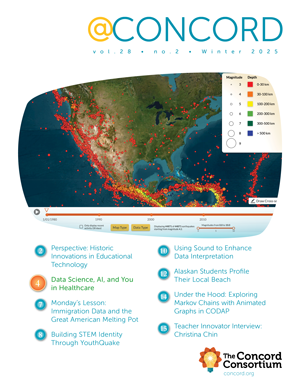Community-Authored Resources for Education, What’s So Smart About a Graph?, Technology and Effective Professional Development, and more in Winter @Concord
Perspective: An Open Letter to President Obama
This is no secret: as a matter of national security, the nation’s math and science educational system urgently needs repair. Dozens of reports from policy experts, industry, researchers, and educators argue that fundamental improvements need to be made immediately. If we continue in our current trajectory, the education of our workforce will be so inferior that business will despair of hiring Americans. Science and technology research will increase its migration abroad. Most troubling, American citizens will be increasingly unable to make informed decisions that require science and quantitative analysis, as already evidenced by our fateful paralysis over global warming, stem cell research, teaching of evolution, and nuclear energy.
Letter from Our President
Across the country, people are debating and discussing change, considering how to move powerful ideas forward while retaining the best of what has been built before. The Concord Consortium will continue to focus on innovation in STEM education in the coming months and years, and I consider it a great honor to become a part of this discussion. Having been selected as the new president to help build upon the amazing foundation Bob Tinker and staff have created is both humbling and exciting. Having this opportunity as the nation holds such a desire for change and innovation is simply unparalleled.
How Can Less Be More?
Phil Morrison first advanced the hypothesis that “less may be more.” In 1963 he was one of an MIT threesome who introduced the idea of science education reform by creating PSSC Physics. He thought students could learn science better by concentrating on a few ideas “to break with the [deductive] Euclidean model ... to go beyond mere verbal and formula-learning.”
Community-Authored Resources for Education
Technology can provide a far better resource that provides the same functions as a textbook, but takes full advantage of computers. This resource would be much more than text on a screen. It would use the best technology has to offer; it would be student oriented, utilizing highly interactive, vivid, inquiry-based activities embedded in intelligent electronic lessons. It would track student use and provide feedback to teachers, giving detailed analysis of student progress. It would be research-based, tied to standards, and well tested. And it would be free.
Monday's Lesson: What's So Smart About a Graph?
Your students are about to use an electronic temperature or force sensor, perhaps for the first time. The data will be displayed in a real-time graph. What is the best way to help your students make sense of the data?
Technology and Effective Professional Development
Too often, professional development focuses separately on either increasing teacher content knowledge or on abstract teaching methods. A common approach is to take graduate level courses in a discipline. The problem with this is that the impact on teaching is so indirect. A brilliant mathematician can fail as a teacher if she lacks an understanding of pedagogy. Research shows no measurable gains in student performance for this approach.
Can They Do It or Do They Just Know How to Do It?
At first glance it seems obvious that simulation-based performance assessments are preferable to traditional question-and-answer tests as a way of assessing students’ understanding, particularly in technical areas. Unlike more static items, simulations provide opportunities to observe student behavior and reasoning in cognitively rich contexts that mirror the complexity of the real world. Using simulations one can assess more than memorization and superficial test-taking skills by confronting students with incompletely defined problems requiring multiple steps for their solution and often affording more than one satisfactory outcome.
Lost in Cyberspace
In Disrupting Class, the authors write about the shifts in many industries caused by what they call “disruptive technologies” and how such shifts affect schools. Because Disrupting Class has created a loud buzz in the education community and beyond, I was eager to read it.

